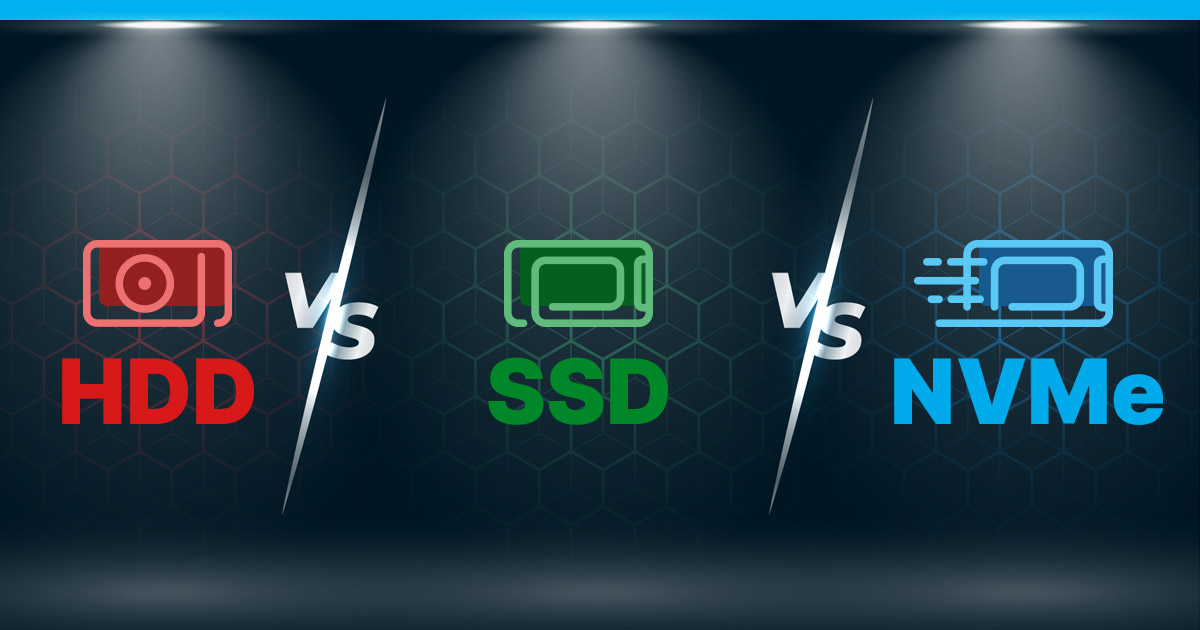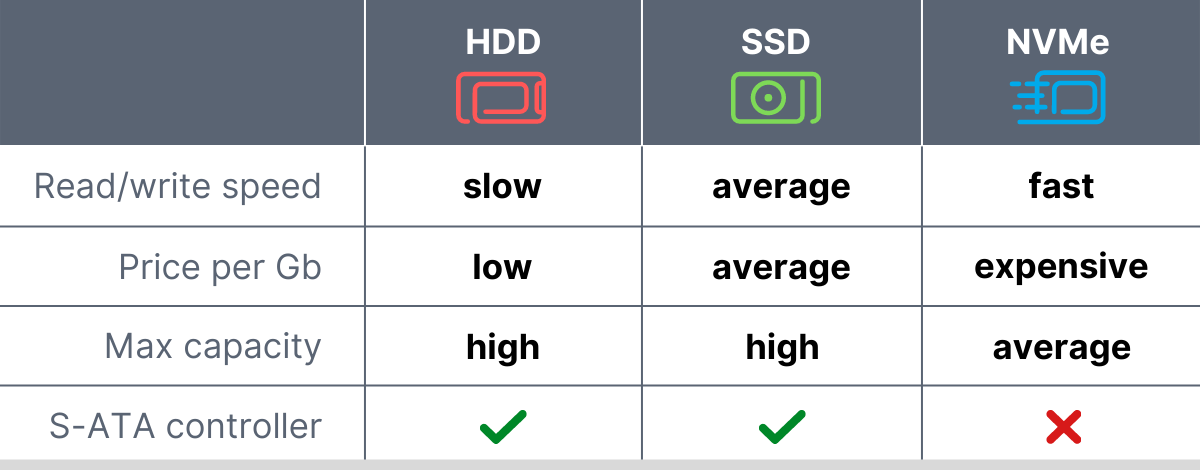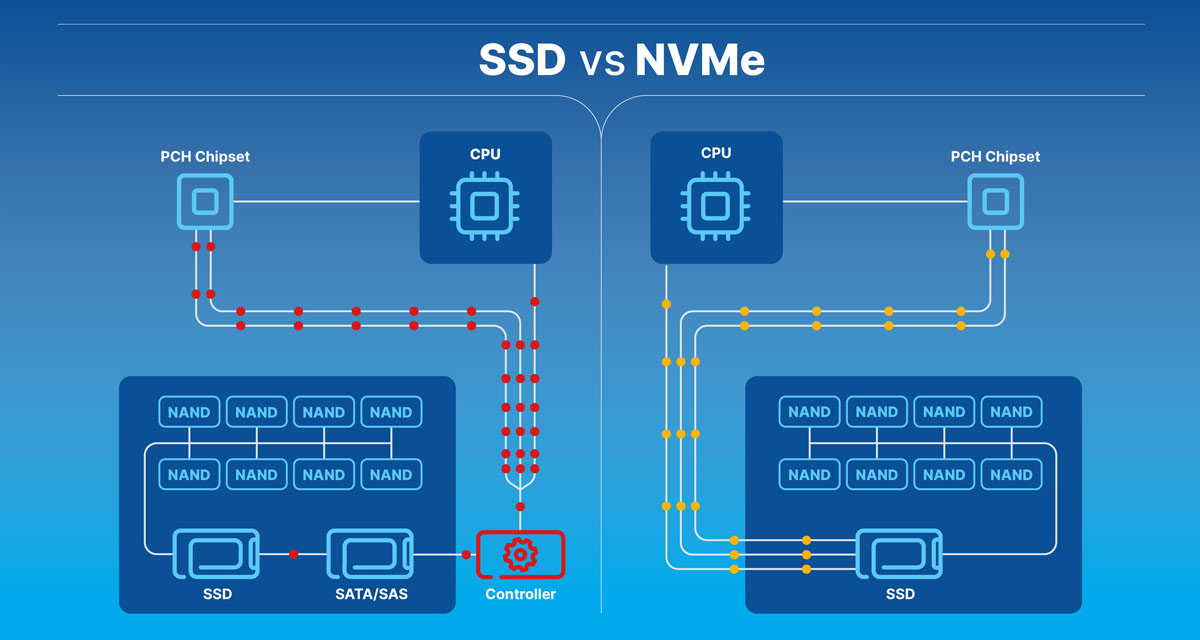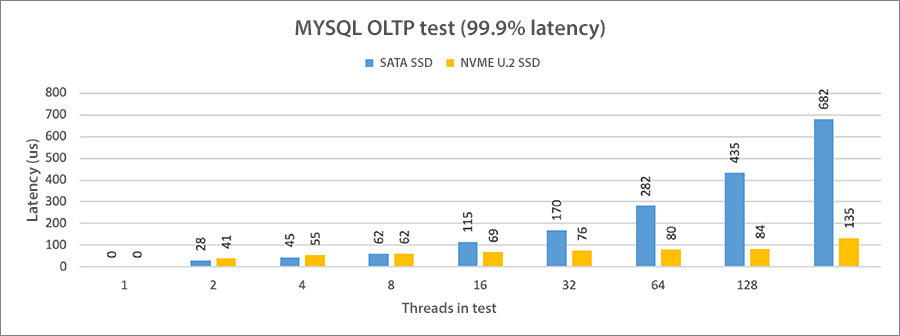
In 2021 we introduced NVMe to our VPS linueup. Now the hardest part of choosing a new server, whether it’s a dedicated server or virtual private server, is the selection of the right hardware that will fit your needs. If you’re like most people, then you try to purchase maximum CPU cores for your budget. You also check how much RAM you’ll get. You’re cautious about having enough storage capacity. But there is one crucial element that most people forget – the storage type.
Not all drives are made equal. There is a huge difference in price and performance between NVMe, SSD and HDD storage. In this article, we’ll guide you through different types of drives so that you can pick the best one for you.
HDD, SSD, NVMe: From Spinning Platters to Lightning-fast Express Drive
HDD: Hard Disk Drives
The oldest of them all, hard disk drives (HDD), is the only one of three based on moving parts – spinning platters and moving needles, recording data on different sectors of the metal disc. The technology itself goes way back to the 50s, when it was introduced by IBM. Although cheapest on the list, they’re also slowest when it comes to read-write operations. Most HDDs can’t exceed maximal S-ATA II speed of ~270 MB/s. HDD is the ultimate solution in case you want to store your data for as little money as possible. But you’ll have to wait more when reading/writing data. Although slower, they’re still popular. Our customers can still encounter HDD drives in Storage VPS or while configuring Dedicated Servers.
Capacity of storage varies greatly, but most drives range somewhere between hundreds of Gigabytes to few Terabytes. In case of virtual instances, we at Contabo offer hard disk space starting from 300 GB.
Home users are sometimes concerned about HDDs’ sensibility to outside shocks or sudden movements. But that’s not really a concern in the case of data centers, because servers are fixed to racks or shelves and not moved around.
SSD: Solid State Drives
This newer type of storage contains no movable parts as it’s flash-based. It’s the same technology you may know from a USB stick. Although the storage technology itself is different, it still uses the same connection interface to the motherboard. There still has to be an S-ATA controller between the drive and motherboard. The SSD read-write speed is significantly faster compared to HDD as it can reach 550 Mb/s.
The compact size of SSD drivers has huge implications for both personal computing and data centers. SSDs are an ideal fit for notebooks and other devices with limited space. The introduction of SSD allowed putting more separate drives into one physical server. Although this improvement doesn’t necessarily increase storage capacity, it is helpful in terms of redundancy and RAID configuration. For that reason, SSD is the standard storage type for data centers. At Contabo, you can find SSD drives in our High-Performance VPS, VDS or bare metal servers. And the price per capacity ratio? SSD is somewhere in the middle between HDD and NVMe. Although there are exceptions, like this $40 000 drive from Nimbus, with 100 TB capacity.
NVMe: Non-Volatile Memory Express
Introduced in 2013, the new “express” drive is the fastest type available on the market. Similar to SSDs, it’s a type of flash storage that contains no moving parts. The “NVM” stands for non-volatile memory, a memory that can store your data even after power is removed. It still uses the same architecture as SSD, but it’s connected directly to the motherboard via PCI express socket. Hence, the small letter “e” at the end.
It can run up to 32 GB/s if we take into consideration the newest PCIe 4.0 connection and 16 separate lanes. NVMe is still far from reaching its full potential though. At Contabo, we’re offering NVMe drives for all types of servers, specifically VPS, VDS and Dedicated Servers.

Why Exactly is NVMe so Much Faster Than Its Predecessors?
In short: Because it’s based on faster PCIe interface, there is no intermediary between the drive and the motherboard. It can also process a lot more commands at the same time.
Architecture
As flash-based SSD technology became mainstream, users benefited greatly from having faster data transfers. Still, they were dependent on the old S-ATA interface. They still had to use the S-ATA (or SAS) controller in order to communicate with the CPU and motherboard. Then in 2007, engineers at Intel got the brilliant idea to connect the same SSD drive to motherboard using a PCI Express slot, which was at that time predominantly used for connecting graphic cards, sound cards or additional network interface cards.
As a result, the new type of storage doesn’t need the S-ATA (SAS) controller and can communicate directly with the motherboard. On top of that, the use of the PCIe allows NVMe to use multiple lanes. Lanes connect PCIe to the motherboard. Each of the lanes uses two wires for sending and two for receiving information simultaneously, hence greater potential for faster exchange.

Queue Depth and Simultaneous Tasks
Not only NVMe doesn’t need a S-ATA or SAS controller, but it also significantly improved the command structure. While SSD only works with 1 command queue, NVMe simultaneously uses 64k command queues. And while SSDs can only send 32 commands per that single queue, NVMe sends up to 64k commands per EACH queue! NVMe allows a higher number of command queues, which means that it can process many more commands at the same time. While SSDs read/read operations are waiting in line, NVMes are juggling many different tasks at once.
The queue depth is especially important for customers who run complex web applications, such as large e-commerce or SaaS application. Then, the whole application can be divided into various different microservices that are processed independent on each other. For instance, think of an eCommerce store. Each customer generates a string of database queries and read-write operations just by browsing the website. Not to mention the whole checkout process. Storage is involved in all these operations and the IOPS visibly impacts customer experience. NVMe can handle more of those tasks separately and with great speed, hence allowing lower latency.
Overall, NVMe works significantly faster with workloads like:
- Website hosting – so visitors to your website get a swifter response time
- SaaS apps – so users of your software can browse your app more smoothly
- Database application – so that you can collect and recall data more quickly
- E-commerce software – loading pages of products will be quicker, hence fewer people will leave your website
- Video files – when editing or exporting video files, you’ll save a ton of time
Here are some impressive stats from one of the most prominent data storage manufacturers, Kingston. As you can see in the picture, the latency is much higher with traditional SSDs. In other words, the server running MySQL data base performs much better. The more threads you’re running simultaneously, the more important the difference is.

Recap: 3 reasons why is NVMe so fast
- No controller: There is no SAS or S-ATA controller between the motherboard and the drive that would slow down the communication
- Queue depth: Thanks to the improved command structure, NVMe is so much better at working with various tasks simultaneously
- Multiple lanes: The PCI express standard offers multiple lanes, up to 16, boosting performance significantly
Purchasing Your New Storage
In the previous part, we’ve described technological differences between all types of storage. Let’s briefly discuss the practical side in case you’re still in doubt about which one to purchase:
HDD: The Best Price / Quality Ratio
If your only criterion is dollars per GB, then you can just go with proven HDDs. Although slow, they offer enough capacity for all types of workloads. Ideal in case you need to park your data somewhere as a backup.
NVMe: When Speed is the King
NVMe is by far the fastest storage on the market. The difference is so staggering that the whole operating system becomes visibly more responsive when installed on top of NVMe. As stated in the previous section, NVMe makes a difference with workloads, such as SaaS apps or database systems. Large individual files are also transferred much faster, which makes it a popular option for video editors.
If you need to run applications where speed is the key, go for NVMe. For example, VPS S equipped with NVMe offers you a fast storage for just €4.99/$6.99.
SSD: The Versatile All-rounder
The SSD drive is somewhere in the middle in terms of performance. Although they can’t compete with NVMe speed, they offer in general much more storage for the same price.
For instance, you can purchase our VPS S equipped with an SSD and get 4x more storage space for the same price as NVMe drive with the equal capacity.
Wrapping up
In this article, we explained all three currently available types of storage: HDD, SSD and NVMe. While hard disc drives still use spinning platters, the other two types contain no moving parts. We also explained, that NVMe is a type of SSD memory, but it uses a different type of interface.
| Moving plates | Solid flash architecture | |
| SATA/SAS Controller | HDD | SSD |
| PCIe Interface | NVMe |
NVMe is so fast because its whole infrastructure is different than SSD or HDD. Having no controller in between drive and motherboard makes data transfer faster. Also, thanks to robust queue depth, NVMe can process many more commands at the same time. There is no doubt that NVMe will become a standard storage type in the foreseeable future. Benefits are apparent – much lower latency, thanks to infrastructure that is faster than most common SSDs.
For now, NVMe storage remains considerably more expensive than standard SSDs. We recommend that you consider purchasing them if you run demanding web applications or regularly work with large video files. Other than that, SSDs and HDDs are still perfectly viable options for many use cases.
